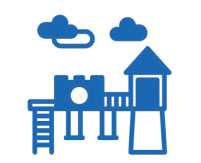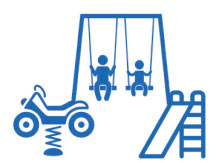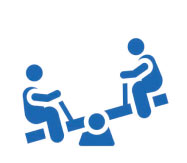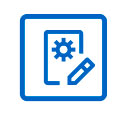Maintenance Class
There are various factors to consider when establishing a playground maintenance plan. How many playgrounds will you be working with? What sort of equipment can be on your playground(s)? How often will the equipment be used? These are just a few questions that would be wise to think about.
At Playgrounds.com, we offer resources that help demystify playground maintenance. We believe that the process behind keeping playgrounds safe and fun places to play should be just as straightforward as playing on them, and it’s for precisely this reason that we’ve created this maintenance guide. Our hope is that it, along with the various other resources on Playgrounds.com, will help add clarity to proper playground maintenance.
Develop a Maintenance Plan
How Many Playgrounds?

What Kind of Equipment?

How Often is the Equipment Used?

Implement the Plan
Remediation Options for Common Playground Issues
Rubber Surfacing
- Cleaning the poured-in-place rubber surface regularly helps prevent rapid deterioration. Using the right products to clean off any debris and litter is the first step to helping your surfacing last longer.
- Poured-in-place rubber may start to flake upon the surface, or curl upon the edges (glue/sealant with UV protection). Cleaning and sealing this surface regularly is the best option for extending the life of your PIP rubber surfacing.
- Using a rubber playground repair kit to fix cracks, punctures, and separations/gaps in the color-wear layer of your rubber surfacing and then resealing the entire playground surface is recommended to prevent further deterioration.
- Replacing poured rubber surfacing is the best option when holes and peeling of the color-wear layer are ripping, and the safety cushion layer is exposed and quickly deteriorating. When you’re doing constant repairs, it’s best to tear out and replace your PIP rubber surfacing.
Loose Mulch Surfacing
- Replenishing mulch regularly to maintain its depth will prevent compaction and injury. Rubber and wooden loose mulch is prone to being washed away during storms, and kicked around and out of the playground by children.
- Check the drainage periodically to make sure it’s working properly. If
water is not drained properly, it’s moisture content can lead to decomposition
and bacteria growth such as mold.
- - Repairing the water drainage system may be needed, depending on condition.
- Check under and on top of loose fill surfacing for any insect nests, and use appropriate and safe products to repel and take care of any bugs and insects in the play area.
Graffiti
- Cleaning products.
- - Remove the graffiti by using a graffiti remover, and after some time rubbing the area gently with a scouring pad.
- Repaint appropriate areas to eliminate graffiti on walls, stone, etc.
- Replace structures/products.
Chains
- Cleaning metal chains, hangers, and bushings to make sure rust is either just on the surface, or more intrusive.
- Sand and use other methods (rust converter, sander, etc.) to eliminate rust on any exposed metal on swing chains and other hardware.
- Replace chains, fasteners, s-hooks, hangers, bushings and/or other moving/missing parts on swings if hardware and parts are rusted beyond repair.
- Replace the whole swingset with new hardware, chains, and/or frame(s).
Seats
- Belt seats, bucket seats, and tire swing seats.
- - Replacing any seats that are showing wear and tear and become a hazard for children’s safety.
Loose Parts
- Screwing and tightening loose parts on the playground.
- Replacing bolts on play equipment.
Rust/Corrosion
- Sand the rust on a swing or other metal surface as soon as you notice its appearance on a playground.Replacing bolts on play equipment.
- Use a rust converter that converts rust (iron oxide) into a stable substance like magnetite.
- Prevent rust from appearing on your swing set or other metal parts by spray painting or using other protectants.
Rust/Corrosion
- Using rust remover, sanders/wire-brushes to remove rust.
- Using a protectant to prevent rust and corrosion (spray paint, chemicals, etc.) from appearing on structures or other metal surfaces.
- You may need to replace whole decks or other structures depending on what structures have metal, or have to replace specific parts (poles, etc.)
Deck Peeling
- Recoat worn playground decking to extend its longevity.
- Purchase a repair kit to patch up damaged and cracked areas on the playground deck(s).
- Replace decks with a new set (whenever recoating and/or repairing is no longer a viable option).
Dents/Holes/Cracks in Slides
- Use the right tools to repair a slide (welding and patching a crack or hole).
- Using the right tools to pop out minor dents in a metal slide.
- Replacing the slide altogether if it’s beyond repair, or the above options don’t work.
Scratches in Plastic
- Recoat worn playground decking to extend its longevity.
- Purchase a repair kit to patch up damaged and cracked areas on the playground deck(s).
- Replace decks with a new set (whenever recoating and/or repairing is no longer a viable option).
CATEGORIES OF MAINTENANCE
Loose-Fill Surfacing
Loose-fill materials are a popular, cost-effective surfacing option for playgrounds. Whether your playground uses rubber mulch or wood mulch, it’s important to ensure that these materials are evenly distributed throughout your playground. This process is as simple as raking the mulch in question to avoid piles of loose-fill materials, but eventually, purchasing and distributing more mulch onto your playground will be necessary to ensure evenness and proper surface depth.
Unitary Surfacing
‘Smooth’ and ‘uniform’ are two words that aptly describe unitary surfacing. By far the most popular unitary surfacing option is poured-in-place rubber, as it requires less maintenance than loose-fill surfacing and can be installed over hard surfaces like concrete or asphalt. Additionally, the rubber used for unitary surfacing is much more durable than wood chips or mulch, and, although poured-in-place rubber carries a higher up-front cost, it will also require less maintenance time and money over the long term compared to loose-fill surfacing.
Signs
Metal signs on playgrounds can rust and wear if not properly maintained. A monthly checkup for rust and weathering can help you know when and if you need to replace your playground signage.
Log Rolls
The bearings used in log rolls to make them rotate are important to pay attention to, as these are essential to proper functionality. Specifically, make sure the bearings of the rotating drum are adequately secure, then ensure that the handholds are properly in place.
Benches & Waste Receptacles
Trash cans are one of the more underlooked and underappreciated aspects of playgrounds, but regularly changing trash bags while ensuring surface cleanliness will go a long way towards making your playground an attractive environment. Benches are another underappreciated category of playground equipment. Regularly polishing wood benches while cleaning the surfaces of metal ones are both great ways to maintain benches. For benches and trash cans, ensure that they’re properly anchored into the ground.
Composite Structures
Since composite structures are installed into the ground, they often won’t require as much maintenance as equipment with moving parts, such as swing sets and merry-go-rounds. Still, you should keep on the lookout for rust build-ups on composite structures, as well as any unevenness among the surfacing surrounding them.
Fencing
Most fencing around playgrounds are made from iron, which, like most metals, has a tendency to rust. Fortunately, the process for rust removal on wrought iron fences is fairly simple. The user will need a fine wire brush, which they will use to scrub the rust spots slowly but steadily until the rust eventually flakes off the fence. Additionally, the user should ensure the hinges of any gates along the fence are well-oiled and properly functioning.
Spring Rockers
As with most moving-part play equipment, an essential part of maintaining spring rockers is ensuring that all components, specifically nuts and bolts, are properly fastened and secured. Also, if using loose-fill surfacing like mulch, make sure an adequate volume of surfacing materials exists in the area immediately around your spring rockers; in the case of a child accidentally falling off, surfacing quality could mean the difference between an injury and non-injury incident.
Freestanding Climbers
As with most moving-part play equipment, an essential part of maintaining spring rockers is ensuring that all components, specifically nuts and bolts, are properly fastened and secured. Also, if using loose-fill surfacing like mulch, make sure an adequate volume of surfacing materials exists in the area immediately around your spring rockers; in the case of a child accidentally falling off, surfacing quality could mean the difference between an injury and non-injury incident.
Swings
If not properly maintained, swing sets carry a high risk of injury for users, making it crucial to check key areas of swing sets and ensure safe functionality. Whether your swing sets utilize S-hooks, chain links, or other connecting fasteners, periodically ensure that these aren’t loose or missing. Also, be on the lookout for excessive wear and tear on the swing seats, as these can and often do come loose if left unchecked.
Freestanding Slides
When it comes to slides, it’s important to check carefully for gaps or protrusions on the surface to ensure that kids don’t get their clothing or other items tangled. Also important is to make sure the exit zone immediately beneath the slide’s exit has adequate surfacing to prevent kids from injuring themselves after sliding.
Fulcrum Seesaws
As the name suggests, one of the most important elements on fulcrum seesaws is the fulcrum, or the area on which the seesaw rests. The reason for this is that, if the fulcrum is damaged and/or if bolts or nuts used to attach the seesaw board to it are loose or missing, users of the seesaw in question are endangered. Carefully checking the fulcrums of your seesaws will help prevent accidental injury for children who use them.
Track Rides
Along with swingsets, track rides are one of the varieties of play equipment most vulnerable to malfunctioning over time if not properly maintained. For this reason, users should periodically ensure that both the handgrip and trolley bearing assembly are securely fastened, and lack wear and tear associated with breakage.
Sand Diggers
Sand diggers are lower risk in terms of injury potential than most motion-based playground equipment, but that doesn’t mean one should not maintain them. Some things to look for on sand diggers include making sure the digger turns on its rotation axis, as well as checking the edges of the digging bucket to ensure there are no sharp edges that could potentially hurt users.
Merry-Go-Rounds
For merry-go-rounds, some focal points for inspection include potentially broken or missing handrails, as well as excessive vertical oscillation; in other words, if your merry-go-round tilts upward or downward when spinning, you’ll likely need to retighten some of the bolts on your merry-go-round. Both of these are potential safety hazards, and, when uncovered, should be addressed accordingly.
Balance Beams
Trash cans are one of the more underlooked and underappreciated aspects of playgrounds, but regularly changing trash bags while ensuring surface cleanliness will go a long way towards making your playground an attractive environment. Benches are another underappreciated category of playground equipment. Regularly polishing wood benches while cleaning the surfaces of metal ones are both great ways to maintain benches. For benches and trash cans, ensure that they’re properly anchored into the ground.
HOW TO DETERMINE FREQUENCY?
High Frequency
- Material/Trash Hazards: These include cans, bottles, trash, broken glass, sharp objects, low-hanging or damaged tree branches, animal feces and other miscellaneous debris. Gloves are recommended to clean up and discard most, if not all items, on your playground.
- Surfacing Hazards: Regular upkeep on surfacing is immensely important for the safety of children, as 70 percent of playground injuries involve falls. The depth of the material on your playground must be measured to ensure it’s deep enough for equipment fall heights. Sweeping and raking may be required/recommended depending on what surfacing you have for your playground.
- Equipment/facility Hazards: This includes missing parts, broken equipment, uncapped ends of pipes and kinked, loose bolts, twisted or broken chains.
Low Frequency
- General Safety Considerations: Generally checks all pieces of play equipment for required signs and labels, crush and shear hazards, and protrusion and entanglement hazards.
- Finishes & Material Conditions: Checking specific types of finishes, surfaces and other materials - some may not apply to all components of play equipment.
- Slides: Checking all slides on the playground to make sure that its bedways and walls are free of debris and smooth, and free of entanglement hazards.
- Gripping and Stepping Components: Checking all handholds and grip-type equipment, as well as making sure all stepping components are up to standards and are tight and secure.
- Swings & Moving Components: Checking to make sure swing chains/cables, hangers, S-hooks, seats, and other components are free from excessive wear and are up to safety standards.
- Fasteners: Checks specific types of fasteners and hardware - may not apply to all play components.
- Protective Surfacing: Surfacing of a playground is checked to make sure the proper surfaces are used and meets a certain impact attenuation criteria.
Record All Maintenance
HOW TO KEEP RECORDS
Warranty Information

Inspection/Audit Records

Maintenance Records
